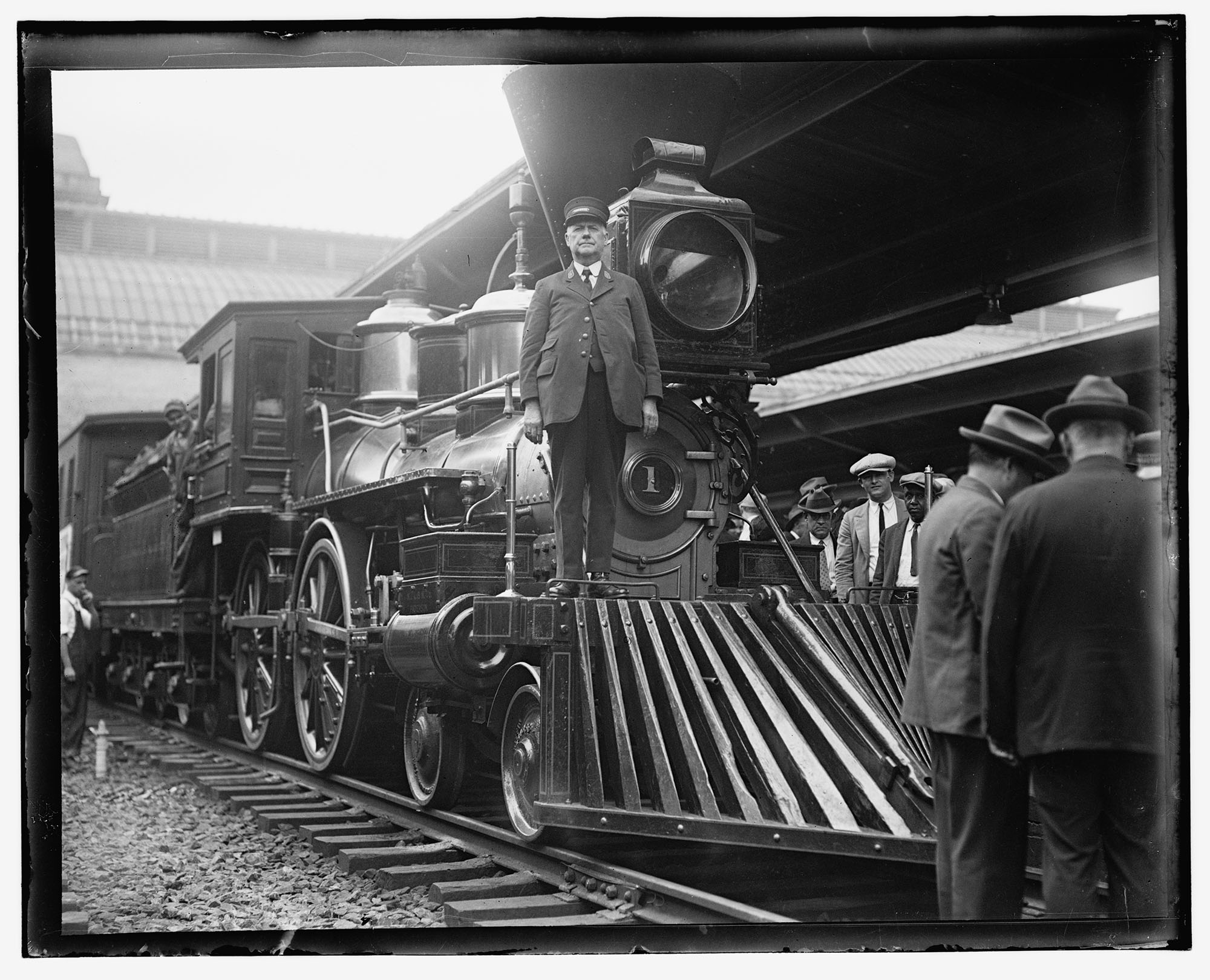|
Vocapedia >
Transport > Railroads
Steam locomotives

Title
[Train in station]
Created / Published
[between 1909 and 1923]
Headings
Glass negatives.
Genre
Glass negatives
Medium
1 negative : glass ; 4 x 5 in. or smaller
Call Number/Physical Location
LC-F8- 44107 [P&P]
Source Collection
National Photo Company Collection (Library of Congress)
Repository
Library of Congress Prints and Photographs Division
Washington, D.C.
20540 USA
http://hdl.loc.gov/loc.pnp/pp.print
Digital Id
npcc 18527 //hdl.loc.gov/loc.pnp/npcc.18527
Library of Congress Control Number
2016820305
Reproduction Number
LC-DIG-npcc-18527 (digital file from original)
https://www.loc.gov/resource/npcc.18527/
4-8-8-4 steam
locomotive USA
— Union Pacific 4014
the largest
operating steam locomotive
in the world —
Union Pacific 4014
was one of 25 4-8-8-4
steam locomotives,
dubbed Big Boys,
manufactured by
the American
Locomotive Company
between 1941 and
1944.
(The 4-8-8-4
designation refers
to the locomotives’
wheel arrangement,
which consists of a
four-wheel leading truck,
two sets of eight
driving wheels
and a four-wheel
trailing truck.)
Weighing a staggering
600 tons,
the 132-foot-long
behemoth
is a living,
breathing testament
to the mechanical
genius of its era.
Unlike passenger
locomotives
belonging to
competing railroads,
Union Pacific’s steam
engines
would forgo
streamlining,
instead roaming the
rails
with their jumble of
gears,
steam hoses and
boiler rivets
exposed to the public
eye.
As a result, the Big
Boy broadcasts
an aesthetic of
efficiency, toughness
and sheer brutality.
https://www.nytimes.com/2022/05/02/
travel/steam-locomotive-union-pacific-4014.html
the locomotive’s
whistle USA
https://www.nytimes.com/2022/05/02/
travel/steam-locomotive-union-pacific-4014.html
cast iron valves
USA
https://www.nytimes.com/2022/05/02/
travel/steam-locomotive-union-pacific-4014.html
driving rods >
chug back and forth
USA
https://www.nytimes.com/2022/05/02/
travel/steam-locomotive-union-pacific-4014.html
the locomotive’s
tender USA
https://www.nytimes.com/2022/05/02/
travel/steam-locomotive-union-pacific-4014.html
passenger cars
USA
https://www.nytimes.com/2022/05/02/
travel/steam-locomotive-union-pacific-4014.html
Britain's most iconic
steam engine > Flying Scotsman USA
The Flying Scotsman
— the first train
to
reach 100 miles per hour,
back in 1934 —
was pulled out of
service in 1963.
http://www.npr.org/sections/thetwo-way/2016/01/08/
462412473/flying-scotsman-hits-the-rails-once-more
Thomas the Tank Engine
UK
https://www.theguardian.com/lifeandstyle/2012/jul/07/
thomas-tank-engine-danger-fear
https://www.theguardian.com/media/2007/jul/26/
bookscomment.books
engineer USA
http://www.npr.org/2015/05/17/
407447315/train-engineer-you-have-to-be-ready-to-act
http://www.npr.org/sections/thetwo-way/2015/05/13/
406380166/ntsb-team-on-its-way-to-investigate-amtrak-derailment
Corpus of news articles
Transport > Rail > Trains > Steam
trains
March 16 1899
The Great Central
Railway
From The Guardian archive
March 16 1899
The Guardian
The Great Central Railway was opened to-day to passenger traffic,
though the goods traffic — apart from coals — will not commence until after
Easter.
Judging by the experiment of this, the opening day, the auguries for passenger
traffic are of the most promising kind. For the present only eight trains are to
be despatched daily from Marylebone — five of them through to Manchester — and
the first of these started this morning at 5 15, being due at its destination at
10 25.
Among those who gathered on the platform at this early hour — which was rendered
anything but pleasant by a continuance of the thick November-like fog which has
been enshrouding London for the last few days — was Mr. Harry Pollitt,
locomotive engineer and son of the general manager, and a cheer was raised as
the five-vehicled corridor train, drawn by a very powerful bogie-wheeled engine,
decorated with the Royal arms as well as with those of the Company, steamed out
of the station with its four solitary passengers.
Yes, these were all the travellers by the first train, with its five cars,
reminding one of Macpherson's "four-and-thirty men and five-and-thirty pipers."
A craving for immortality or a wish to accomplish a feat may have been the main
motive which induced this early rising, and in any case somebody must have been
the first travellers from London to Manchester by Great Central Railway. All the
other seven outward trains, on the other hand, were pretty full, especially the
1 15 special express, which was timed to reach Manchester at 6 15, or in five
hours.
By and by, when the road becomes hard and settled, the new Company promises to
reduce the time of transit to the same limit as the competing lines. Among those
who watched the departure of some of the other trains were Lord Cross and
Colonel Hutton, directors, and Mr. Haig-Brown, super intendent of the line,
while throughout the day the station was thronged with a crowd of sightseers.
There were also two [through trains] to Leicester and one to York, while from
Nottingham there were no fewer than four special trains, carrying the employees
of the Corporation of that city on a trip to London, which, starting at
intervals of a quarter of an hour, commencing with noon, steamed into Marylebone
only about a quarter of an hour behind their time. This was a most gratifying
commencement.
Travellers and spectators were loud in their admiration of the corridor trains,
with their three first-class and two third-class. The Nottingham trippers were
whisked to London in four hours all but nine minutes.
From The Guardian
archive > March 16 1899 >
The Great Central Railway,
G,
Republished 16.3.2007,
p. 40,
http://digital.guardian.co.uk/guardian/2007/03/16/
pages/ber40.shtml
Related > Anglonautes >
Vocapedia
trains
land > streets,
roads, railroads >
pedestrians,
bikes,
cars, lowriders,
taxis,
trucks, buses, coaches,
trains
transportation
space
time
|